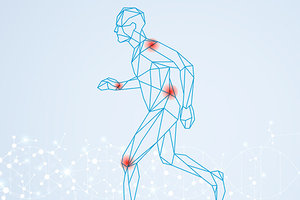There are many articles that have thoroughly discussed the current state of pain management in our health care system. I won't bore you with more of the same statistics of pain occurrence, opioid abuse, and medical mistake numbers.
- We, as a community, need more scientific research showing the benefits and results that TCM brings patients across the globe.
- Integration is being called for across all forms of medicine looking to improve the quality of care for all patients. We need to be able to better communicate with other medical professionals and benefit by each other's strengths as it best helps our patients.
Yet, these two trends seem to have a wide gap between them that needs to be bridged. The current Western scientific study model does not easily study or measure integration nor their benefits. Research tends to want one solution for one problem, but this is contrary to what we know of the human body. There are many contributing factors to any imbalance we find in the body.
 These imbalances may include: physical, chemical, emotional, lifestyle, electromagnetic, or thermal, to name a few. The sum of TCM (what I would call a complete system of medicine) and additional medical integration has the potential for a great synergistic effect. This seems to not only be the hope of practitioners or theorists, but clinical truth expressed through the experience of mixed modality and integrative medicine professionals. So, in this four-part article series we will embark on the journey of looking at pain from different perspectives.
These imbalances may include: physical, chemical, emotional, lifestyle, electromagnetic, or thermal, to name a few. The sum of TCM (what I would call a complete system of medicine) and additional medical integration has the potential for a great synergistic effect. This seems to not only be the hope of practitioners or theorists, but clinical truth expressed through the experience of mixed modality and integrative medicine professionals. So, in this four-part article series we will embark on the journey of looking at pain from different perspectives.
My point of view has been expanded by many of my wonderful mentors and fabulous patients that have trusted me as a health advocate and teammate over the last 15 years. These perspectives are constantly adapting with an open mind to the new information and experiences coming our way.
Part 1: Physical Pain
Structural injuries are some of the most common complaints that acupuncturists see in the clinic. Sprain, strain, tear, inflammation, swelling, aches, and such are present in many descriptions and diagnoses. As we are asked to assist our patients in pain, we often zoom in and treat locally. This treatment type has many benefits including stimulating the healing process of the inflamed tissue, assisting in the flow of qi, blood, lymph, neuro-energetics, etc. But can we do better than this? Let's walk through some questions that tend to be key to providing exceptional care.
Why did this happen? Notice I did not say "how" this happened. How this happened is the common explanation that we hear from our patient, "I fell and hurt my shoulder," or "my wrist hurts because I type on my laptop." "I was running and rolled my ankle," or "my hip pain is from arthritis… it is because of my age." The "why" immediately dives deeper.
Why was your shoulder susceptible to the injury? Why does only one wrist hurt from your work on the computer? Why did your ankle roll on that side and not the other? Why do you have the arthritis on one hip and not the other? Is one hip older than the other? I know these questions may make you chuckle or roll your eyes, but these questions are the start of an important path that leads to more questions and hopefully treatment answers. The process allows for greater understanding, connection to the body, ownership of the situation, and control of the next step.
Zooming Out
More commonly than not, much of the why is found away from the site of pain. When we zoom out, we can see things that are lost when you're too close to the pain. Here are a few examples of such, in the case of knee pain:
- Could knee pain be caused by an unstable hip that is causing the knee to collapse valgus?
- Or the inability of the hip to internally rotate so the torque of a golf swing in focused at the knee?
- Is the lack of ankle mobility increasing the demand on the knee?
- What about the opposite shoulder… if it doesn't move correctly when you walk/run would that create a greater demand on the knee? (if you think I am reaching too far here, try running for 5 minutes, only moving one arm and see how you feel).
Another thing that happens all to often is that someone presents with knee pain, but you can easily see most of their body weight is shifted to the side of pain. Doesn't the body instinctively shift weight and demand away from pain? Maybe the pain is not the fault of the knee. In any of the situations suggested above, it is easy to consider treating the painful knee locally may only get subpar results that do not last as long as patient, nor practitioner wants. Keys to remember with zooming out:
- Look at the whole posture while standing, moving, and doing what recreates the pain.
- Is there something that is different on one side than the other? Why?
- Where is the weight distribution? Forward, back, right, left?
- Is the body rotated? Chest, shoulders, hips, knees, feet?
Trauma & Overuse Injuries
Trauma happens. We cannot prepare for or prevent everything. However, it is smart to educate our patients on the importance of being ready for the unexpected. Better alignment, movement mechanics, and other health markers have shown decreased negative reactions to trauma (slips and falls, auto accidents, etc.).
Posing the question of "why" even in traumatic scenarios brings frequent epiphanies. This is in line with how "overuse injuries" occur. I often tell my patient: "It is not the fault of the movement or activity… but rather the position of the body you take into that activity and the form in which you perform the movement." We are designed to move. I believe that humans with optimal mechanics do not get overuse injuries, they get tired. It is the function of our system to fatigue long before avascular tissue destruction. I call overuse injuries "overly mis-used injuries."
Let us empower our patients to regain their health and increase what they can do as they age rather than continually restrict them because they are getting too old for this and that.
Cause vs. Effect
In physical medicine the cause and effect are too often mistaken as the same. Many think:
- My shoulder hurts and was diagnosed with a torn rotator cuff. So, the tear is causing the pain.
- Meniscus is torn, that's why my knee hurts and is swollen when I run on it. But why have studies found that many people with torn meniscus have no pain at all? Or that the knee that hurts has a more minor meniscal tear than that of the pain-free knee?
- Arthritis is why I have the pain around the joint. But is it? Arthritis, I would suggest, is the evidence that there is faulty movement patterns and misuse—not the other way around.
I like to think of most physical pain this way, there is inflammation and damaged tissue. This is the effect of mis-use of the tissue. But I would estimate that 95 percent of the cases I work with, the reason the tissue was the damaged is due to the faulty movement pattern related to poor posture, aka the cause. Pain doesn't usually show up at the site of dysfunction, but rather compensation. So, it is imperative that we treat beyond the site of pain and also address the dysfunction.
Treatment & Integration
I encourage a holistic approach and replicate the thought process seen in other techniques, to our practice of TCM. After evaluation for the cause and effect, treat the injured tissue (the effect). Focus on speeding up the healing process and repairing the tissue as fast as possible with the appropriate tools for the job (Acupuncture, gua-sha, cupping, e-stim, moxa, or maybe laser therapy).
Next, or simultaneously, we need to address the cause. This can be stimulating muscle deficiencies, clearing stagnation from meridians, treating scar tissue, releasing fascial snags, trigger point therapy, and/or helping to lessen muscle tension imbalances of opposing sides of a joint or sets of joints. The goal of this portion of the treatment protocol is to improve the compensative movement pattern/s associated to the injury. Daily therapeutic exercises and breath-work are sent home with the patient to help maintain the benefits of the treatment along with preventing re-injury.
Empowering patients to fix themselves and take control of their healing journey has become my favorite part. By providing clear recommendations and at home therapeutic protocols, the patient is given the opportunity to move forward without depending on anyone else. The mindset can shift as they invest in their health.
Exercise therapy can be simple, or as complex as you want to make it. If you don't feel very skilled at prescribing exercises, think simple balancing exercise, such as isometric contract/release reps of the lengthened muscles at the posture imbalance. This is a great place for Qi-gong and Tai Chi. Additional resources from posture-based programs such as the Egoscue Method and Foundation Training, are highly recommended to support TCM in practice.
"Treat the tissue that has been injured, but also treat the imbalance that led to the injured tissue."
Click here for more information about Dustin Dillberg, DACM, LAc, PAS.




